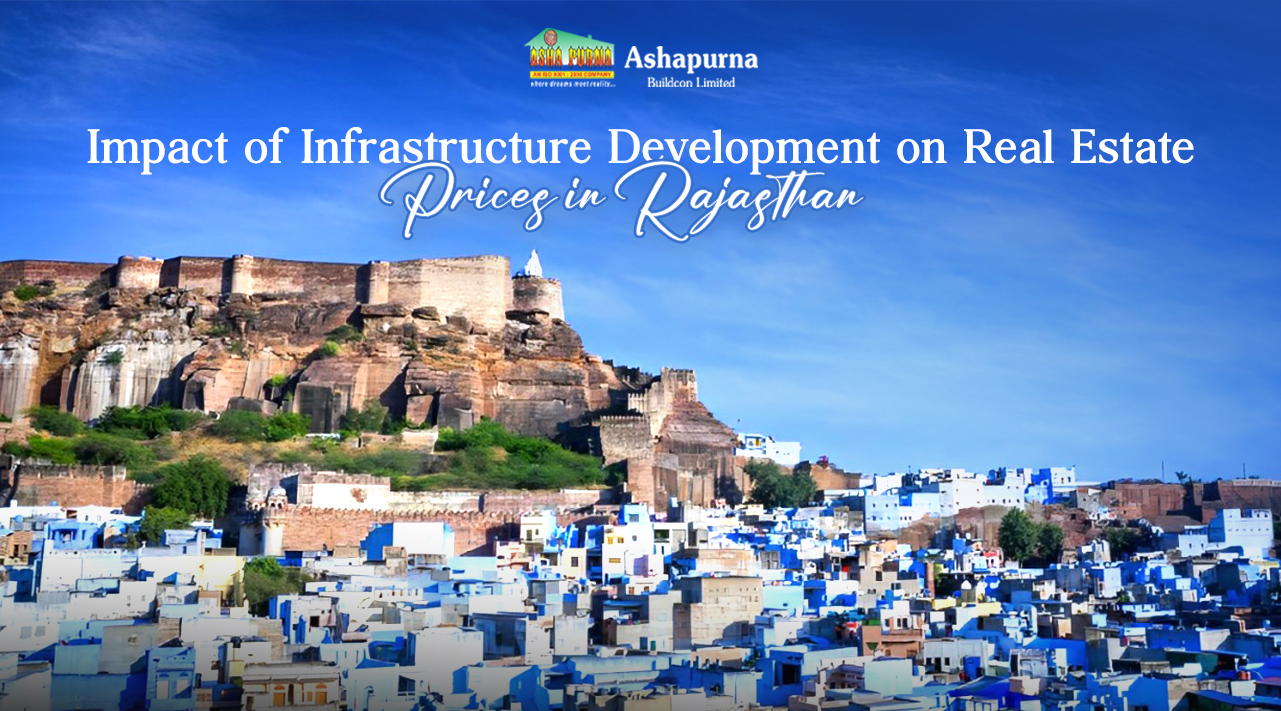Infrastructure development is the backbone of economic progress and plays a pivotal role in shaping the real estate sector. Rajasthan, known for its historical landmarks and evolving urban landscape, has witnessed substantial growth in infrastructure, contributing significantly to the appreciation of real estate prices. For Ashapurna Buildcon, a prominent name in the real estate sector, understanding the influence of infrastructure on property prices is essential for leveraging opportunities and delivering value to stakeholders.
This article delves into the relationship between infrastructure development and real estate price dynamics in Rajasthan, supported by government data, insights from organizations like the Jaipur Development Authority (JDA), and compliance with regulations such as RERA.
1. Enhanced Connectivity and Real Estate Growth
Connectivity is one of the most critical factors in real estate appreciation. Rajasthan’s infrastructure development projects, such as highways, railways, and airports, have bridged gaps between cities and towns, leading to increased demand for real estate in strategically located areas.
Highways and Expressways
- Delhi-Mumbai Industrial Corridor (DMIC): This ambitious project passes through Rajasthan, covering major cities like Jaipur, Udaipur, and Kota. The DMIC has catalyzed economic growth, leading to higher demand for industrial and residential properties in its vicinity.
- Jodhpur-Pali Expressway: This project has significantly improved accessibility to areas like Jodhpur, benefiting projects such as Ashapurna NRI, which is strategically located along this corridor.
According to data from the Ministry of Road Transport and Highways, Rajasthan has seen an 18% growth in national highway length in the last five years, which has directly impacted property prices in adjoining areas.
Railway Infrastructure
The development of new railway lines and the modernization of existing networks have made intercity travel more efficient. The introduction of semi-high-speed trains on routes like Jaipur-Delhi has also contributed to the rising popularity of suburban living.
Airports and Regional Connectivity
The expansion of the Jaipur International Airport and the upcoming Greenfield airport in Kota have made Rajasthan more accessible, attracting businesses and residents alike. Enhanced air connectivity has also boosted property prices near airport zones.
2. Urbanization and Smart City Initiatives
Urbanization has been a game-changer for Rajasthan’s real estate market. Government initiatives under the Smart Cities Mission have transformed cities like Jaipur, Udaipur, and Jodhpur into hubs of modern infrastructure and urban convenience.
Smart City Impact
- Improved drainage, water supply, and waste management systems in Jaipur have enhanced the city’s livability index.
- Smart traffic management systems and better road networks have reduced congestion, making these cities more attractive to investors and residents.
The Jaipur Development Authority (JDA) has been instrumental in planning and executing these projects. JDA’s master plans and guidelines have ensured organized urban growth, which has had a positive impact on real estate prices.
3. Role of Industrial and Commercial Growth
Rajasthan’s push for industrialization has resulted in the establishment of numerous industrial parks and Special Economic Zones (SEZs). These initiatives have created job opportunities and increased the demand for residential and commercial real estate.
SEZs and Industrial Clusters
- Mahindra World City, Jaipur: Spread over 3,000 acres, this SEZ has attracted multinational corporations, creating demand for nearby residential properties.
- Boranada Industrial Area in Jodhpur: This area has become a hub for small and medium-scale industries, leading to a surge in real estate prices.
According to the Department of Industries, Rajasthan, the state has seen a 12% year-on-year increase in industrial investments, driving demand for both residential and commercial spaces.
4. Social Infrastructure as a Catalyst
The development of social infrastructure, including schools, hospitals, and recreational spaces, has significantly influenced property values. Families and individuals prioritize areas with access to quality social amenities, which has led to an appreciation in property prices in these zones.
Education and Healthcare
- Rajasthan’s investment in education through initiatives like Rajiv Gandhi Finishing School for Women and premier institutions like IIT Jodhpur and AIIMS Jodhpur has made cities like Jodhpur and Jaipur attractive for families.
- The presence of world-class hospitals such as Fortis Escorts in Jaipur and Medipulse in Jodhpur has further boosted the appeal of these cities.
Recreational Spaces
Modern recreational amenities, including shopping malls and green parks, have become integral to urban living. Properties near such facilities tend to command a premium.
5. RERA’s Role in Ensuring Market Transparency
The Real Estate Regulatory Authority (RERA) has brought transparency and accountability to Rajasthan’s real estate sector. For companies like Ashapurna Buildcon, RERA compliance ensures trust and credibility among buyers.
Impact of RERA
- Increased buyer confidence due to legal protection and streamlined processes.
- Enhanced quality of projects, as developers are mandated to adhere to timelines and specifications.
According to the RERA Rajasthan website, over 3,500 projects have been registered under the authority, ensuring that buyers have access to verified and reliable property options.
6. Tourism as a Real Estate Driver
Rajasthan’s robust tourism industry, supported by infrastructure development, has positively impacted the real estate sector. The expansion of tourism-related infrastructure, such as hotels, resorts, and second homes, has created opportunities for investors.
Airport Expansions
The expansion of air connectivity to international destinations has made Rajasthan a preferred choice for NRIs looking to invest in luxury properties.
Heritage Hotels and Resorts
The rise in demand for heritage-style hotels and resorts has increased property values in cities like Udaipur and Jaisalmer.
7. Challenges and Future Prospects
While infrastructure development has positively impacted Rajasthan’s real estate sector, challenges such as land acquisition disputes and regulatory delays persist. However, with government initiatives focusing on ease of doing business and continuous investment in infrastructure, the future looks promising.
Government Data and Insights
According to the National Infrastructure Pipeline (NIP), Rajasthan is set to receive investments of over ₹1.5 lakh crore in the next five years, with a significant portion allocated to urban infrastructure and transportation.
Conclusion
Infrastructure development has undeniably been a cornerstone for the growth of Rajasthan’s real estate market. Enhanced connectivity, industrialization, and urbanization have led to increased property demand and appreciation in value. For Ashapurna Buildcon, aligning projects with these infrastructural advancements and ensuring compliance with regulations like RERA will be key to capitalizing on these opportunities.
As Rajasthan continues its journey of modernization, the synergy between infrastructure and real estate will remain a driving force, shaping the state’s economic landscape and offering immense potential for growth

